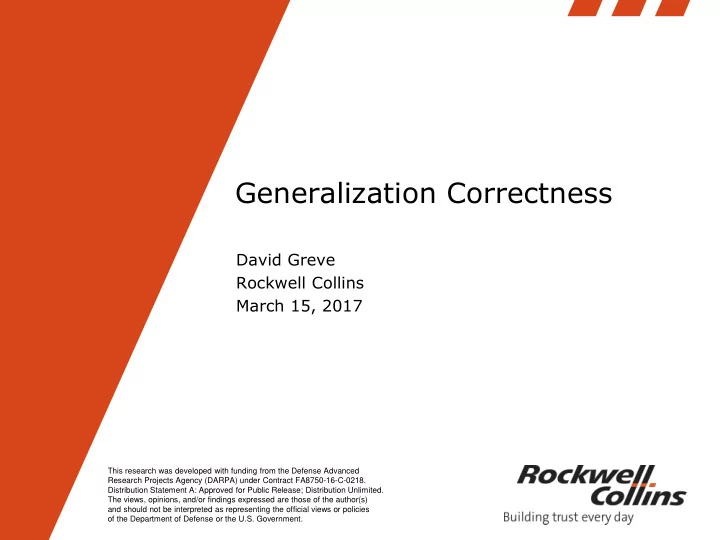

Generalization Correctness David Greve Rockwell Collins March 15, 2017 This research was developed with funding from the Defense Advanced Research Projects Agency (DARPA) under Contract FA8750-16-C-0218. Distribution Statement A: Approved for Public Release; Distribution Unlimited. The views, opinions, and/or findings expressed are those of the author(s) and should not be interpreted as representing the official views or policies of the Department of Defense or the U.S. Government.
Problem Statement solution constraint • Given – System Model – Constraint – Solution provided by Constraint Solver • Generate a Generalization – Convert a single solution into a set of solutions – Express Result Concisely • Usually Generalization != Constraint • Result is Inexact Generalization 2
Generalization Illustration • Computed via Symbolic Simulation – System Model + Constraint – Original Solution – Simulation is Approximate (Lossy) Model • Representational constraints E X = T A Constraint = T Y = F B Z = T Generalization • Is the Generalization Correct? – Formalize Correctness – Articulate Generalization Rules – Prove Rules Satisfy Correctness 3
Generalization Correctness Statements • Top Level Correctness Statement – Generalization Contains Original Solution – Generalization is a Subset of Original Constraint • Invariants – Can be enforced incrementally • During Symbolic Simulation – Reduce to Correctness when applied to top level constraint • Correctness Invariants – 1. Evaluating Solution on Generalization must be the same as Evaluating Solution on original expression – 2. An input whose evaluation differs from that of the solution on the original expression must also differ on the Generalization 4
Generalization Rules • Generalizing Boolean Expressions – AND, OR, NOT, ID • One Choice: – Drop Terms or Not? • Visualization – State Space • Original Solution is one Point – Organized as Truth Table w/to A,B • Consider rules for Generalizing AND – OR follows from De Morgan’s 5
Rule #1: (AND F F) • Correctness Invariants – 1. Evaluating Solution on Generalization must be the same as Evaluating Solution on original expression – 2. An input whose evaluation differs from that of the solution on the original expression must also differ on the Generalization • Generalization Rule #1 – If both expressions evaluate to False, we can either keep both or keep just one 6
Rule #2: (AND T T) • Correctness Invariants – 1. Evaluating Solution on Generalization must be the same as Evaluating Solution on original expression – 2. An input whose evaluation differs from that of the solution on the original expression must also differ on the Generalization • Generalization Rule #2 – If both expressions evaluate to True, then we must keep both 7
Rule #3: (AND T F) • Correctness Invariants – 1. Evaluating Solution on Generalization must be the same as Evaluating Solution on original expression – 2. An input whose evaluation differs from that of the solution on the original expression must also differ on the Generalization • Generalization Rule #3 – If the expressions evaluate to different values, we can either keep both or keep just the False expression 8
ACL2 Model • Defined an expression evaluator – Expression and variable binding – AND, OR, NOT, IDs • Used encapsulation to characterize 3 Generalization rules for AND – Choice is .. pragmatic • Defined a depth-first generalizer – Returns a “generalized” expression – NOT,ID performs no simplification – Encapsulated function generalizes AND expressions – De Morgan’s rule to simplify OR • Formalized Correctness Invariants • Proved that generalizer satisfied invariants 9
Expression Evaluator (defun eval-expr (expr env) (case-match expr (('and x y) (let ((x (eval-expr x env)) (y (eval-expr y env))) (and x y))) (('or x y) (let ((x (eval-expr x env)) (y (eval-expr y env))) (or x y))) (('not x) (let ((x (eval-expr x env))) (not x))) (('id n) (nth n env)) (& expr))) 10
Generalizer Formalization (defun gen-expr (expr sln) (case-match expr (('and x y) (let ((genx (gen-expr x sln)) (geny (gen-expr y sln))) Applies ‘and’ (gen-and genx geny sln))) Rules (('or x y) (let ((genx (gen-expr x sln)) (geny (gen-expr y sln))) (gen-or genx geny sln))) (('not x) (let ((genx (gen-expr x sln))) (not-expr genx))) (& expr))) 11
Invariant Proofs original original solution expression (defthm invariant-1 (iff (eval-expr (gen-expr expr sln) sln) (eval-expr expr sln)) :hints (("Goal" :induct (gen-expr expr sln)))) • Correctness Invariants – 1. Evaluating Solution on Generalization must be the same as Evaluating Solution on original expression – 2. An input whose evaluation differs from that of the solution on the original expression must also differ on the Generalization 12
Invariant Proofs arbitrary vector original solution (defthm invariant-2 (implies (iff (eval-expr expr any) (not (eval-expr expr sln))) (iff (eval-expr (gen-expr expr sln) any) (eval-expr expr any))) :hints (("Goal" :induct (gen-expr expr sln) :do-not-induct t))) • Correctness Invariants – 1. Evaluating Solution on Generalization must be the same as Evaluating Solution on original expression – 2. An input whose evaluation differs from that of the solution on the original expression must also differ on the Generalization PROOF FAILED! 13
Rule #3: (AND T F) • Generalization Performed Depth-First – Solution space may get smaller (per correctness statement) – Predicate boundaries move closer to original solution • Generalization Rule #3 – If the expressions evaluate to different values, we may keep only the False expression 14
Conclusion • We assumed that “Doing Nothing” was conservative – If you never change the expression, it trivially satisfies correctness • We were wrong ! • It is easy to make these kinds of mistakes – ACL2 can help during algorithmic development • Accomplishments – Formalized a notion of correctness for Generalization – Formalized rules for Generalization – Proved Generalization procedure • Corrected an error in our original Generalization rules 15
Recommend
More recommend